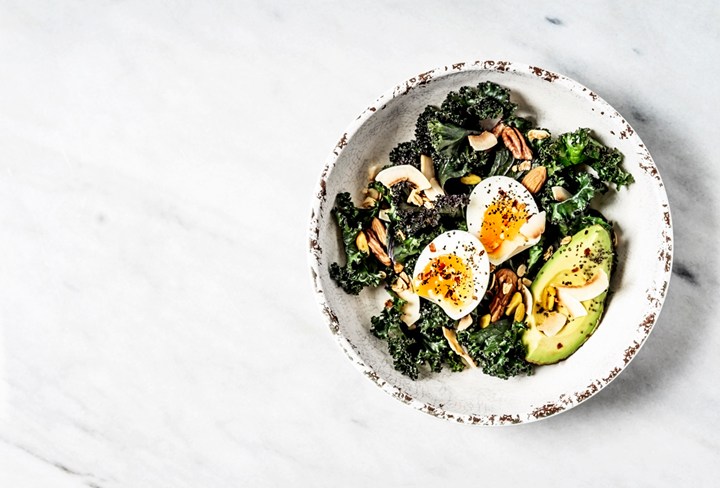Everything you need to know about the OMAD diet – And whether it’s actually safe

An expert weighs in.
By Lucy Bode
July 24 2020
There’s no one-size-fits-all when it comes to dieting. While some people can easily function after 16 hours of fasting, others (*raises hand*) would seriously struggle without downing carbs at hourly intervals.
Belong to the former camp? Allow us to introduce you to the OMAD diet (short for 'one meal a day.') Put simply, it’s a plan that focuses less on what you’re eating and more on when you eat it.
"Think of OMAD as intermittent fasting on steroids" Dena Champion of The Ohio State University Wexner Medical Centre explains. "OMAD is literally when someone eats one meal daily during one hour of the day and then fasts the other 23 hours." You are allowed to drink black coffee or other non-calorie drinks during that fasting time—but nothing else.”
While there are no restrictions on how many calories can be eaten during this window, it’s advised that you sit down for your meal at the same time each day. You see, it’s all about consistency – and adhering to a set of rules known as the ‘4 ones.'
- You should only be eating one meal per day
- You can only eat within one hour of your four-hour eating window
- You must eat off an 11-inch diameter plate
- Your meal shouldn't be more than three inches high on your plate
Curious about what this meal might look like plated up? Here's a breakdown of what someone on the OMAD might eat, depending on whether their eating window is closer to breakfast or dinner. Worth noting: these meals are purely examples not recommendations.
Breakfast:
- 1 Cup Oats = 267 kcal
- 1/4 Cup Walnuts = 190 kcal
- 1 tbsp Flaxseed = 35 kcal
- 1/2 Cup Skim Milk = 60 kcal
- 2 Turkey Sausages = 132 kcal
- 1/2 Cup Strawberries = 35 kcal
- 1 Cup Orange Juice = 122 kcal
- 2 Large Poached Eggs = 143 kcal
- 5 Cup Kale = 49 kcal
- 1 Tbsp Olive Oil = 120 kcal
- 2 tbsp Parmesan Cheese = 78 kcal
- Total = 1,232 kcal
Dinner:
- 85g Grilled Salmon = 120 kcal
- 1 Cup Roasted Brussels Sprouts = 36 kcal
- 1/2 Cup Quinoa = 262 kcal
- 1 Tablespoon Olive Oil = 120 kcal
- 1 Rasher Bacon = 224 kcal
- 1/2 Cup Rice Pudding w/ Skim Milk = 142 kcal
- 1 Cup Steamed Baby Carrots = 51 kcal
- 1 Small Apple = 100 kcal
- Almond Butter = 200 kcal
- Total = 1,255 kcal
So far, so straight-forward... But what are the pros and cons?
Similar to the 16:8 and 5:2 diet, OMAD is a form of intermittent fasting, which numerous studies have linked to weight loss, reduced inflammation, clearer skin and improved sleep. It may also be convenient for those on-the-go who are too time-poor to prep brekkie, snacks, lunch and dinner daily. On the flip side, there are certain risks involved with this diet.
Not only can adopting the OMAD way of eating cause unstable blood sugar levels (which in turn leads to fatigue, headaches and unintentional ketosis) if your one meal a day isn’t nutrient-dense enough, you’ll likely develop deficiencies. After all, a decreased intake of food means decreased intake of beneficial vitamins and minerals.
And although plenty of people sing OMAD’s praises online, as clinical dietitian Rebecca Elbaum from the Montefiore Medical Centre in New York says, the negatives far outweigh the positives.
"Healthy weight loss will be whatever is the most sustainable over a lifetime," she explains. "This includes a healthy, balanced diet and regular exercise."
Elbaum wouldn’t recommend the OMAD diet to her healthiest clients, let alone anyone who's pregnant, breastfeeding, recovering from disordered eating, has diabetes, regularly exercises or lifts weights. In addition, she advises that certain at-risk groups (e.g. the elderly, children and those with pre-existing health conditions that require medication steer very clear, as not getting a regular intake of calories can cause serious complications.
If you are interested in exploring fasting, a less restrictive version (say, the 16:8 diet) would be the way to go. Still, it’s worth chatting to talk to your GP about your options and how best to work IF into your lifestyle… safely, that is.
Image credits: Getty






